Issue:
April 2025
Artisans in Okinawa are rewriting the script on the much-maligned condiment
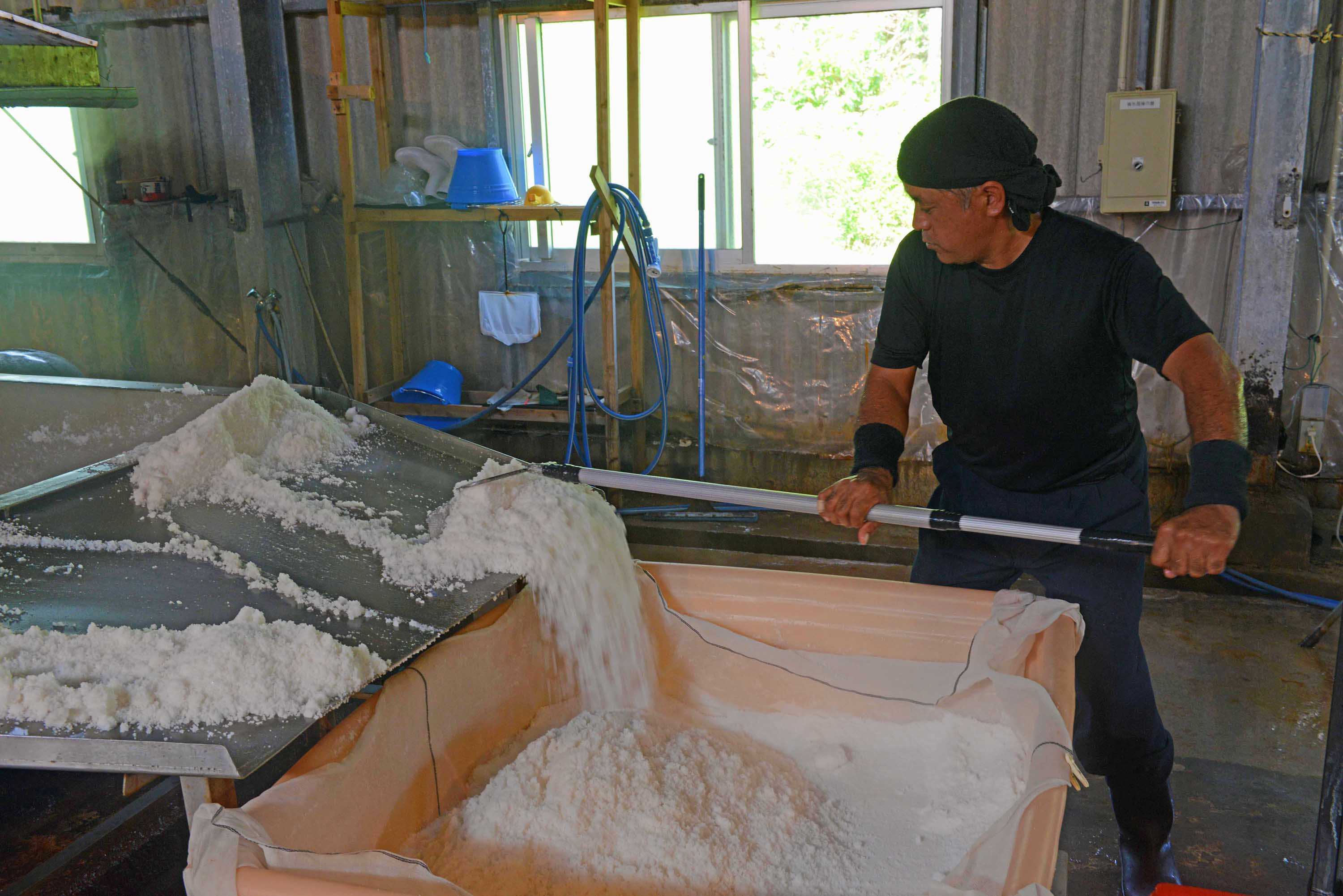
Conventional wisdom maintains that even slightly immoderate quantities of salt can lead to hypertension, lower fluid retention, increased risk of strokes, kidney damage and osteoporosis. And yet, the body, if it is to function properly, needs a regular intake of salt. So, do many of the dishes we consume, which would be bland without it. The expression “salt of the earth” implies a robustness, ruddy good health, a gritty personality.
In Japan, which boasts nearly 30,000 kilometers of coastline, it’s not difficult to find artisanal salt makers. According to records, commercial salt production in the southern islands of Okinawa began in a tidal wetland near the prefectural capital of Naha in 1694. In his 19th-century guidebook on Ryukyuan diet therapy, Tokashiki Pechin Tsukan, a physician to the royal court, claimed that salt, known in Okinawan as masu, “removes toxins, purifies qi energy, and expels lung diseases”. Despite sensing that some of Tsukan’s recommendations, such as the admonition to scrub teeth and rinse the eyes in saline solutions, could be taken – pun intended – with a large pinch of salt, there was, nonetheless, something progressive in his aligning of salt with good health.
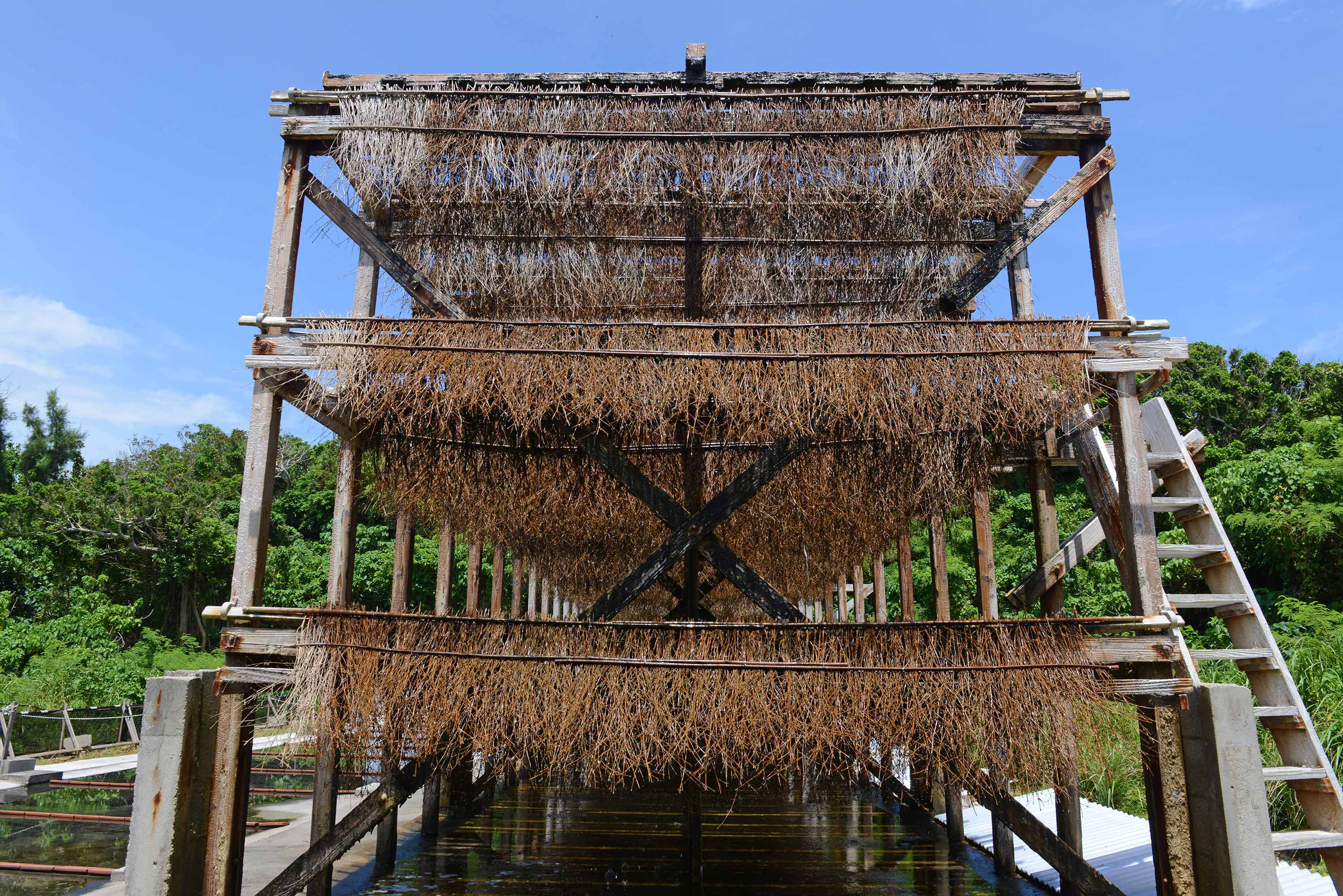
Salt collection and processing methods differ regionally, the most common approach involving the concentration of seawater through evaporation in salt fields, before being crystalized in cauldrons or holding tanks. Another method, commonly practiced in Okinawa involves exposing atomized seawater to warm air currents. The relatively fast evaporation period ensures a higher-than-average mineral retention, far more than common table salt, which in most cases contains iodine. Surprisingly, heirloom varieties, though more labor intensive in producing, are not prohibitively costly. As a specialty product, Okinawan salt is being quite inventively marketed, not just as a table condiment, but as an element in everything from cosmetics and spa treatment to body care products, biscuits and ice cream.
Over the years, I’ve followed the salt trail through several Okinawan islands, including the Yaeyama group in the far southwest. Pumped from almost 20 meters below the clear, coral waters of Ishigakijima, the island produces a salt with an unusually rich mineral profile, which includes over 40 types. Here, a unique, low temperature misting process transforms seawater into a crystalized form. The salt is then stored for eight years in large outdoor jars filled with brine.
The salt made on Miyakojima, to the north of Ishigakijima, reflects the geology of an island surrounded by coral and layers of Ryukyu limestone. Seawater passes through holes and crevices in the rocks, which function as filters, removing impurities, and, at the same time infusing calcium from the coral. Using reef cavities to make salt was not universally practiced throughout Okinawa. Until the start of the Taisho era (1912-1926), every village had its own salt field or salt beach.
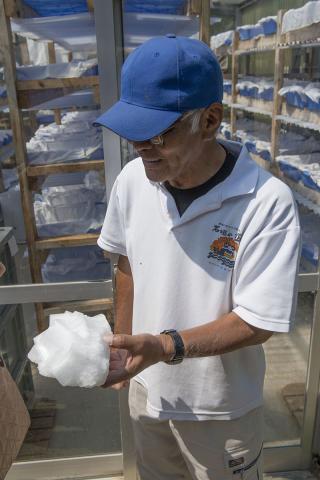
A large chunk of crystalized salt on the island of Ishigaki island. 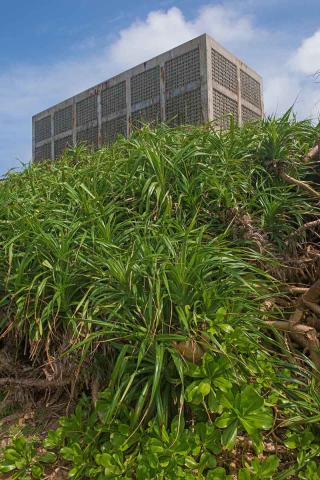
Cinder block processing buildings at the Aguni Salt Factory. 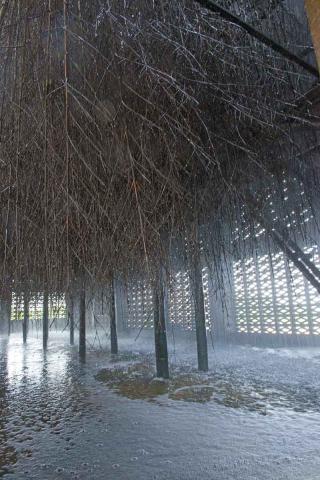
A forest of inverted, salt-crystalizing branches at the Aguni Salt Factory.
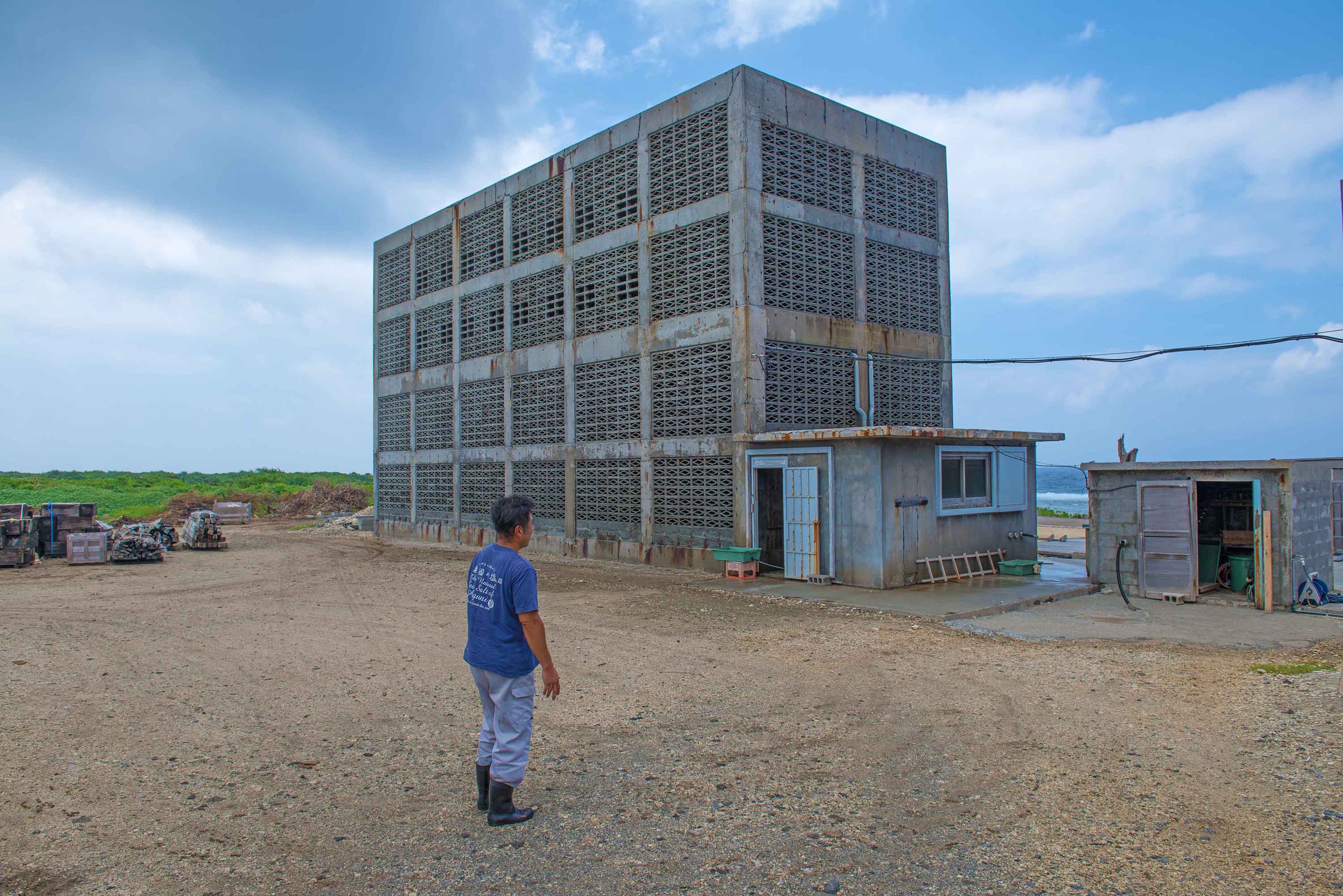
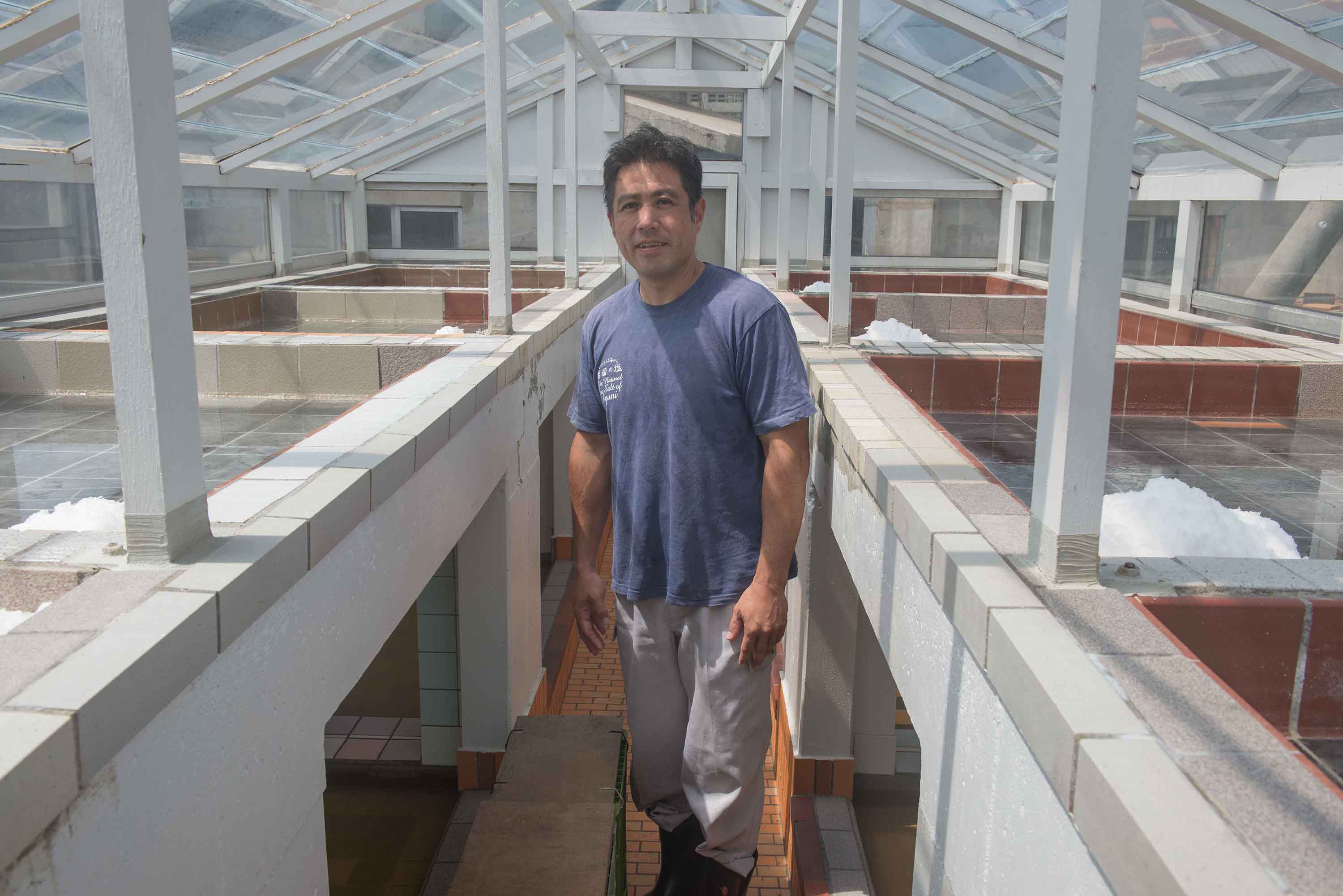
Agunijima, an island of roughly 700 residents, two hours east of Naha’s Tomari Port, produces a superior, much sought after salt using a special technique. Aeriated, 10-meter-high cement blocks, functioning as wind barriers, are built around a frame supporting inverted bamboo branches, through which seawater is pumped and dribbled. Moisture evaporates in the spaces between the bamboo, raising, in the process, salt concentration levels. The saltwater is then either poured into a flat iron pan and slowly heated using firewood, or dried in shallow troughs inside greenhouses. The resulting high ion content, benefiting from the island’s surrounding waters, which are free of wastage and other pollutants, accounts for the high quality of Aguni-shio (Aguni salt).
Takaesu Seienjo sits at the end of an unmade road facing the East China Sea. The salt factory, run by Masaru Takaesu and his wife, stands behind a tangled grove of semi-tropical deigo, adan and broadleaf trees on Hamahigajima, the very picture of a small Okinawan island. An authentic, hand-crafted experience, Takaesu Seienjo also happens to be visitor-friendly and accessible, Takaesu laughing when I asked him if I needed to make an appointment to see him at work. The couple single-handedly run an operation that manages to be both relaxed and professional.
As Takaesu shows me around, I’m pleased to note the absence of hygienic, bio-tech wear common in more sanitized operations, the salt maker in this instance, dressed in casual boots, loose black pantaloons, T-shirt, matching head scarf, and the type of cotton wrist bands used by tennis players to concentrate their energy and soak up sweat.
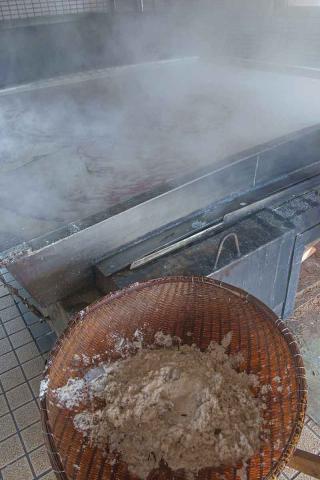
Takaesu’s Hamahiga salt is manufactured using the so-called “flowing salt fields” technique, a descending method similar to the one I observed on Agunijima. The procedure helps to remove unwanted deposits of calcium. The water then flows onto a brick foundation, where it is recirculated through the branches, a process that, using sun and wind, evaporates water, leaving crystals of salt on the branches. Collected in large pans, salt particles are boiled, raked, then placed into large ceramic jars. Nigari, a brine concentrate collected during the boiling process, is added, the solution then left to dry. The result is a mellow tasting arajio (rock salt) that, because it is naturally dried, conveys little of the bitterness normally associated with the product. Because of weather conditions, shifting seasons and tides, this handmade process cannot be mass-produced. A three-step procedure, consisting of the harvesting of salt water, filtering, and finally, the extraction of salt solids through heating of the concentrate, salt production is tough work, requiring muscle and manual dexterity.
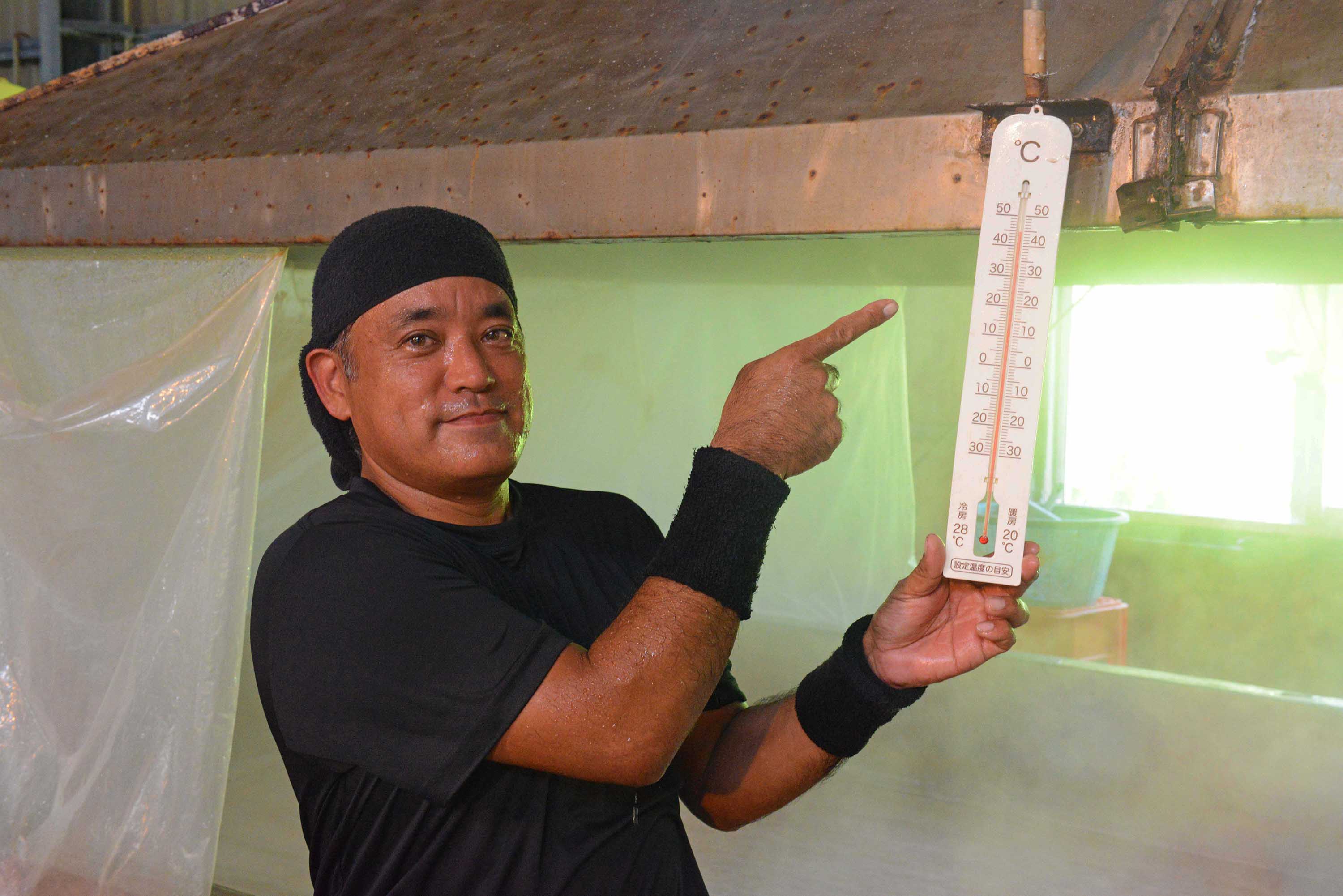
Takaesu invites me to return a little later, when he will be steaming, raking and purifying the salt he has been collecting. An hour later, I am stepping out of the soggy, sub-tropical Okinawan air into his factory, little prepared for temperatures that will rise to 50C. The saline air may be good for the body and palate, but it can be death for cameras. With mine dripping by now with salt condensation, I switch to using my cellphone, its flat surfacing easily wiped.
Among the products for sale at Takaesu Seienjo are magnesium salt, a kokuto, or black sugar blend, a sparkling, pink offering that looks similar to Himalayan salt, the enigmatic Full Moon Crystal Salt, and a yellow Hamahige shikuwasa brand made with Okinawan lime. Takaesu’s salt enterprise convinced me of the feasibility of healthy salt, the creation of a product that, packed with minerals like iron, copper, zinc, magnesium and potassium, elements containing lower degrees of sodium nitrate, a notorious artery-hardener, can actually help to reduce conditions like high blood pressure.
It may be some time before Okinawan salt takes its place as an essential item on health food shelves, or in fashionable restaurants alongside gourmet brands like Sicilian Trapani, Sel de Guerande and Maldon, but my visits to these small-scale artisanal operations forced me to revise a lot of assumptions about the life-withering effects of salt.
Stephen Mansfield is a Japan-based writer and photographer whose work has appeared in more than 60 magazines, newspapers and journals worldwide. He is the author of 20 books.

